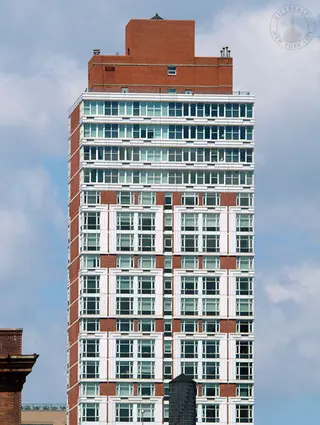 Carter Horsley
Carter HorsleyDec 23, 2011
Carter's Review
This 194-unit, apartment building was erected by RFR Holdings, Inc., in 2000 and was the first residential tower designed by architect Michael Graves to be built in the city.
Graves, who is best known for his unbuilt designs for an addition to the Whitney Museum of American Art on Madison Avenue at 75th Street, his elegant and colorful architectural drawings, his line of kitchenware, a civic building in Portland, Oregon, the headquarters of the Humana company, and hotels for Disneyworld in Florida, had designed a handsome, mixed-use tower for Sotheby's nearby at York Avenue and 72nd Street that was never built.
He was one of a group of young architects known as the "New York Five" that came to prominence in the 1970's. The group also included Robert A. M. Stern, Peter Eisenman, Charles Gwathmey and Richard Meier. Originally, the group's aesthetics were inspired by the modernity of LeCorbusier, an influence that still can be seen in the work of Gwathmey and Meier, and was taken to more complex levels by Eisenman. Stern, however, became a leading proponent of Post-Modernism and in the year 2000 had two high-rise apartment buildings under construction in Manhattan.
Graves departed from the group's famous "white" palette and opted for colorful designs, or pastiches. He and Stern both did major buildings for Disney in Orlando that were not without humor. While his artistic talents have always been respected, some of his architectural designs, especially the Whitney Museum project, have been very controversial.
At the Whitney, Graves proposed three different schemes to build new structures adjacent to and over the existing building designed in Brutalist style by Marcel Breuer. The proposals were attacked by some critics for being too dominant over the famous cantilevered Breuer building.
Here, Graves has designed a very bold and busy façade fronting on First Avenue.
The windows are large and multi-paned and the façade is divided into three-story segments with slightly protruding bandcourses and the lower two floors of which have the windows surrounded by large white reveals. The strong horizontal emphasis of the avenue façade, however, is balanced somewhat awkwardly by a narrow vertical separation between the center reveals.
Furthermore, the larger base of the building reverses this patterning and has a central, slightly indented wide center section flanked by darker wings, all above a two-story section with a dark grid window pattern. The windows of the top two floors of the base's wings, moreover, have bright white mullions and spandrels that are the best part of the overall design as they form crosses.
The top of the tower is capped with a completely different, horizontally-oriented façade treatment and the north and south sides of the tower are mostly blank. The tower occupies the middle of the block on the avenue between 75th and 76th Streets and its sidestreet entrance, about 100 feet from the avenue, has a different façade and is about 7 stories tall as the tower rises only over the avenue frontage.
In their fine book, "New York 2000, Architecture Between the Bicentennial and the Millenium," Robert A. M. Stern, David Fishman and Jacob Tilove wrote that "H. Thomas O'Hara planned the apartments, but Graves took responsibility for the lobby, which featured maple-paneled walls and limestone floors, as well as the 15,000-square-foot courtyard where the South African sculptor Danie de Jager installed a series of fourteen, life-size bronze statues of impalas, the American antelope." "A fifteenth impala was attached to the façade above the apartment building's primary entrance on Seventy-sixth Street," the authors added.
The building has a concierge, a garage with valet parking, a health club, a business center and conference room, a children's playroom, a private cinema room, a garden with fountain, gas-burning fireplaces and some apartments with 12-foot ceilings.
The upper floors have very good views and the area has very good neighborhood shopping and numerous restaurants. Sotheby's, the auction house, is at 72nd Street and York Avenue. While not convenient to the subways, there is good cross-town bus service on 72nd and 79th Streets.

- Condo built in 2000
- 4 apartments currently for sale ($925K to $2.495M)
- 1 apartment currently for rent ($0)
- Located in Lenox Hill
- 194 total apartments 194 total apartments
- 10 recent sales ($617.5K to $2.5M)
- Doorman
- Pets Allowed

 6sqft delivers the latest on real estate, architecture, and design, straight from New York City.
6sqft delivers the latest on real estate, architecture, and design, straight from New York City.
